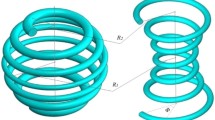Abstract
The paper discusses the necessary conditions for attaining a design yielding a spring-rate function which is variable. The dynamic response is expressed in terms of velocity and displacement by means of a phase plot (integral curve). A method is presented which allows the generation of a ramp function of multiple shaft splines fitting into a serrated hub to yield the required spring-rate function of the torsion bar. It is shown that the engagement length of splines results in a change of the effective length of the elastic torsion spring. The ramp function can be generated directly from a known spring-rate function. In particular, the constant-frequency variable-mass system is considered.
Similar content being viewed by others
Abbreviations
- A :
-
integrating constant
- a :
-
moment arm (in.)
- c :
-
damping constant (lb-sec/in.),C: damping parameter (1/sec)
- C 1 :
-
integrating constant (lb-in.)
- F :
-
force (lb)
- g :
-
gravitational constant (386 in./sec2)
- G :
-
shear modulus (psi)
- I p,I i :
-
polar moment of inertia (in.4); mass moment of inertia (lb-in./sec2)
- K, k :
-
springrate (lb/in., lb-in./rad)
- L :
-
beam length (in.), connecting-rod length (in.)
- L 0 :
-
initial beam length (in.)
- M :
-
moment (lb-in.)
- M i :
-
initial moment (lb-in.)
- O :
-
origin, reference plane
- r :
-
radius of gyration, moment arm (in.)
- s :
-
displacement (in.)
- T :
-
period (sec/cycle)
- t :
-
time (sec)
- W i :
-
initial load (lb)
- x :
-
coordinate, displacement (in.)
- x 1 :
-
distance (in.)
- y :
-
dx/dt velocity (in./sec)
- y 1 :
-
coordinate (in.)
- α:
-
shape factor, average twist angle (rad)
- γ:
-
shear angle (rad)
- ϕ, ψ, θ:
-
twist angle (rad)
- ω:
-
circular frequency (rad/sec)
Bibliography
Polhemus, V.D., andKehoe, L.J., Jr., “Cadillac's Air Suspension for the Eldorado Brougham,”Trans. SAE,66,475 (1958).
Thomson, W. T., Vibration Theory and Application, 67, Prentice-Hall, Inc., N.J.
Sachs, H. K., “Theoretical Study on Elastic Properties of Bellows Type Air Spring Suspension,”Developments in Mechanics, Vol. 1, 112–127, Plenum Press, New York, 1961).
Weigand, A., “Progressive Springs for Vehicles,” German, “Zur Theorie der Fahrzeugfederung, insbesondere der progressiven Federung,” Forsch. Ing. Wes.,11,309–323 (1940).
Roller, A. E., “Design and Calculation of Progressive Compression Springs,” Ind. Math. Jnl.,10,Part 1, Detroit, Mich. (1960).
Stoker, T. J., Nonlinear Vibrations, Interscience Puboishers, Inc., Ch. IV, 81, New York.
Sachs, H. K., “Vibration Isolation of a Quasi-linear System,” Ind. Math. Jnl. Vol. 14, Part 2 (1964), Detroit, Also: “Transmissibility of an Elastically Coupled System,” Proc. 9th Midwestern Conf. of Mechanics, to be published.
See also, Repen, E., “Analysis of a Progressive Rate Rorsion Shaft Spring,” Master's Thesis, Approved, May 1966, Wayne State University, Detroit, Mich.
Author information
Authors and Affiliations
Rights and permissions
About this article
Cite this article
Sachs, H.K. Criteria of design for progressive torsion-bar springs. Experimental Mechanics 7, 105–109 (1967). https://doi.org/10.1007/BF02326376
Issue Date:
DOI: https://doi.org/10.1007/BF02326376




